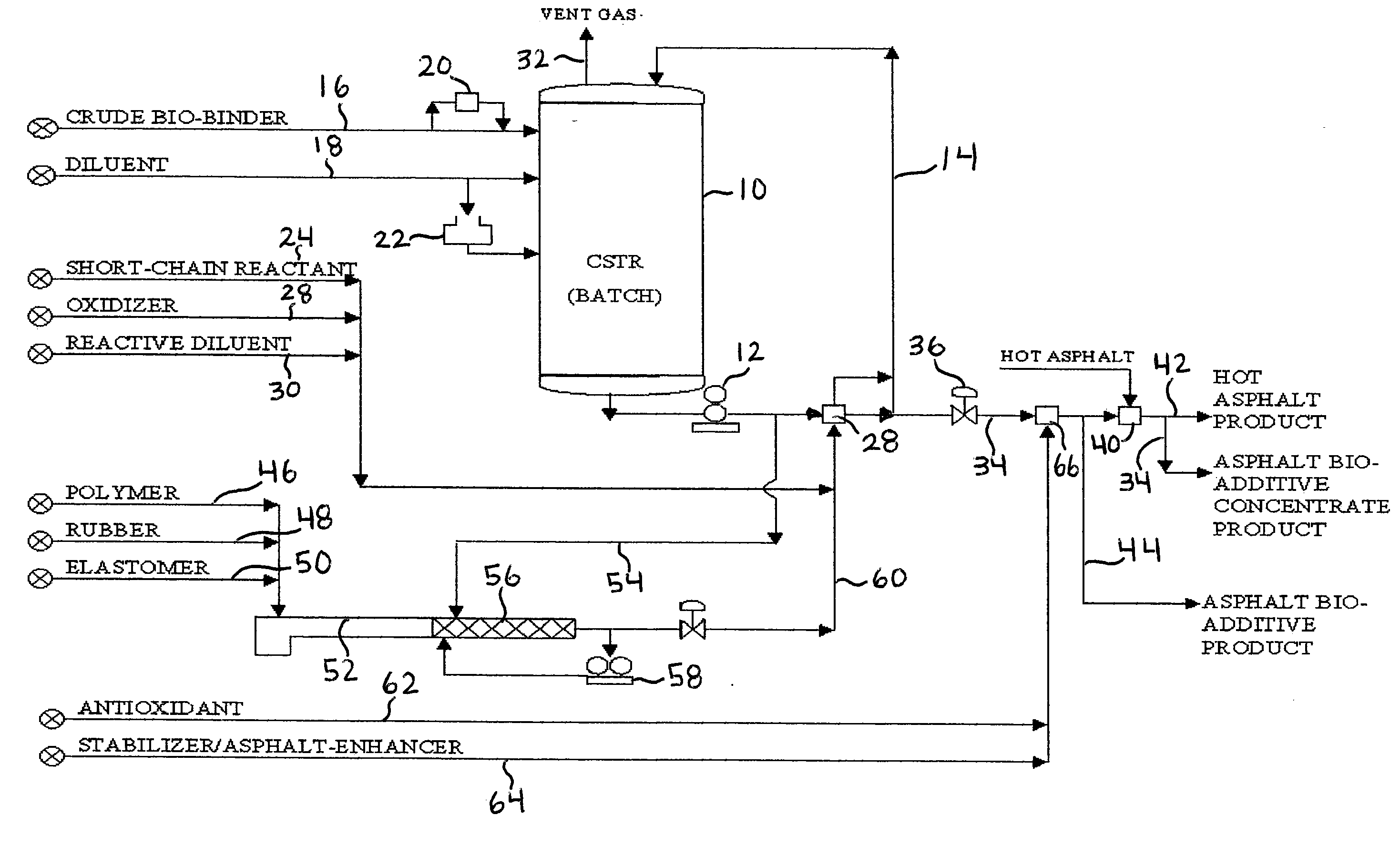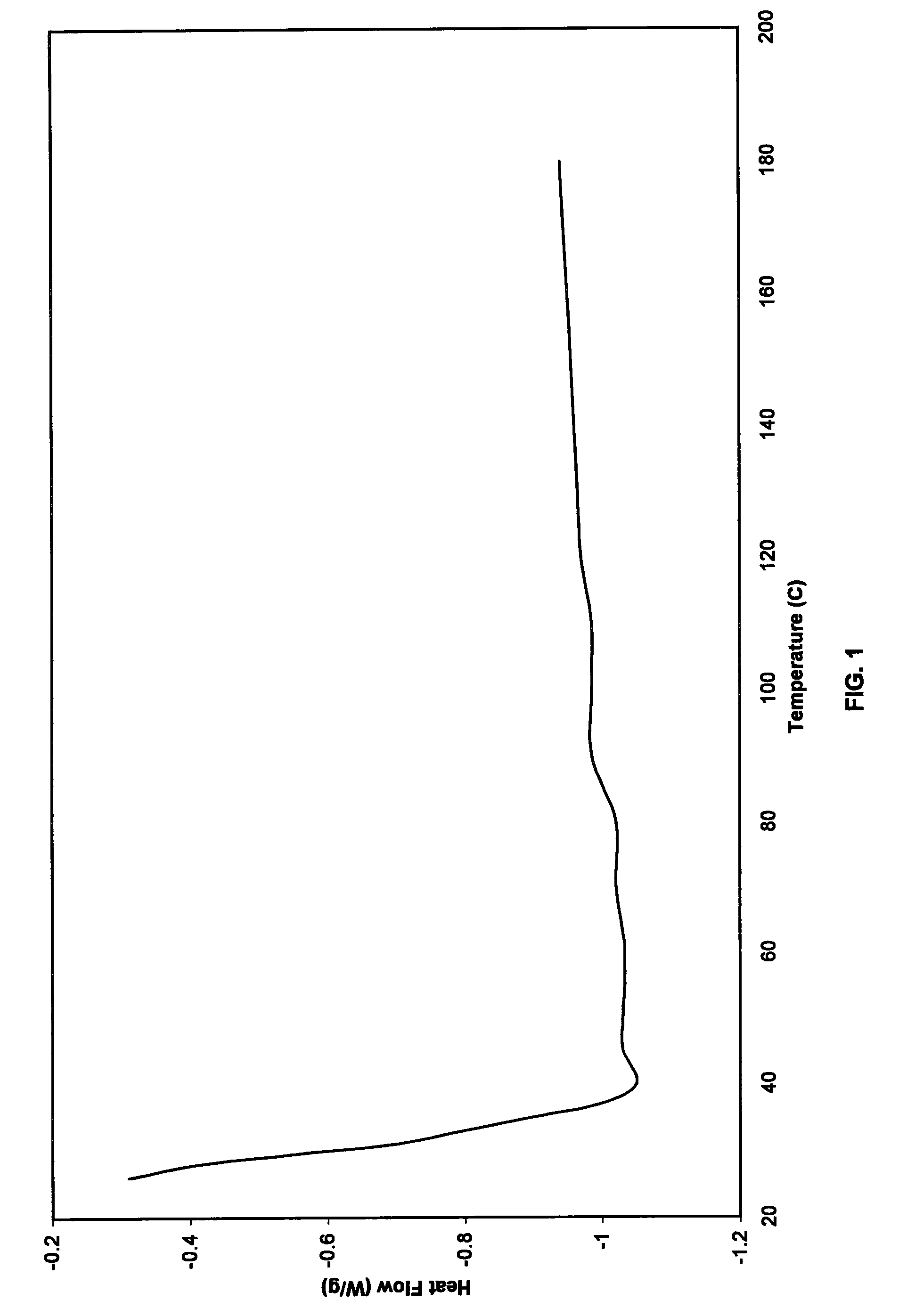Petroleum Asphalts Modified by Liquefied Biomass Additives
a petroleum asphalt and biomass additive technology, applied in the direction of building components, building insulations, constructions, etc., can solve the problems of cracking patterns on pavement surfaces, severe damage on many highways and streets, and the conventional repair of asphalt overlays is usually only effective, so as to improve durability.
- Summary
- Abstract
- Description
- Claims
- Application Information
AI Technical Summary
Benefits of technology
Problems solved by technology
Method used
Image
Examples
example 1
[0062]Because of the instability of bio-binders at high temperatures, such as when heated above about 110° C., it may be necessary to use capping agents to prevent their deterioration, evidenced by smoking, when higher process temperatures are contemplated. Accordingly, the intended goal was to stop the smoking so that the heated products could pass the flash-point test of at least 230° C. This was critical so the products could result as a direct substitute in the hot mix plant where the asphalt is heated to over 230° C. routinely. Thus, the mild bio-binder of Table 1 was used for testing reactions with vegetable oils, acrylic monomers, and thermoset polyester monomers.
[0063]A. A mixture of bio-binder (400 gm) and linseed oil (40 gm) was melted at about 120° C., at which point a slight reaction was observed. By adding a few drops of tertiary butyl peroxybenzoate (TBPB), a more definite reaction occurred. When the sample was then heated above 150° C., the degree of smoking was found...
example 2
[0066]This example shows an asphalt bio-additive that improves both low-temperature and high-temperature properties of petroleum asphalts by incorporating a polypropylene-ethylene copolymer elastomer (55 / 45 wt percent) that has a low Young's Modulus. 500 gm of bio-binder were mixed well with 400 gm of Texaco fluidized catalytic cracking main column bottoms (FCC) as a diluent and heated to 120° C. in a vessel. 100 gm of linseed oil and 0.2 gm of tertiary butyl peroxybenzoate as oxidizer were added to the bio-binder while mixing and continuing to gradually raise the temperature. When the blend reached 160° C. (which is approximately 5° C. above the melting temperature of a polypropylene-ethylene copolymer elastomer), 200 g of the copolymer elastomer were added to the reactive blend, along with 1,200 gm of an AC-20 asphalt for dilution and easier mixing.
[0067]After about five minutes of continuous high-shear mixing at temperatures between 160° C. and 170° C., another 0.2 gm of tertiary...
example 3
[0069]Ground tire rubber is added to asphalt to provide several road benefits. These are increased low-temperature ductility, increased adhesion to aggregates, improved resistance to aging, increased deformative elastic recovery, and reduced tire noise. Normally about 18-20 wt percent of finely ground rubber (less than about 40 mesh) is added to asphalt and heated for 1-3 hours at a temperature above 220° C. to achieve these properties. Typically the rubber is swelled at that high temperature by the oils and asphalt components to form a gel-like network in the asphalt. An objective of the invention is to be able to use a coarser ground rubber (10 mesh or larger), and to achieve similar or better results with less rubber.
[0070]Accordingly, the mild bio-binder mentioned above was reacted with course tire rubber in the following manner. 500 gm of course-ground rubber was soaked in 750 gm of FCC oil at 120° C. for 3 hours to swell the rubber. This mixture was fed into an extruder at abo...
PUM
| Property | Measurement | Unit |
|---|---|---|
| thickness | aaaaa | aaaaa |
| temperatures | aaaaa | aaaaa |
| pressure | aaaaa | aaaaa |
Abstract
Description
Claims
Application Information
 Login to View More
Login to View More - R&D
- Intellectual Property
- Life Sciences
- Materials
- Tech Scout
- Unparalleled Data Quality
- Higher Quality Content
- 60% Fewer Hallucinations
Browse by: Latest US Patents, China's latest patents, Technical Efficacy Thesaurus, Application Domain, Technology Topic, Popular Technical Reports.
© 2025 PatSnap. All rights reserved.Legal|Privacy policy|Modern Slavery Act Transparency Statement|Sitemap|About US| Contact US: help@patsnap.com



